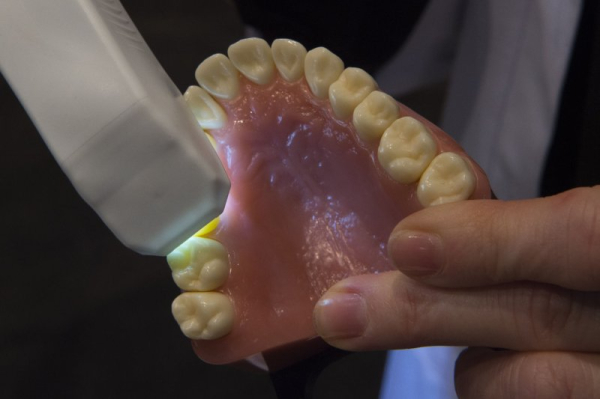Science seeks to tap amazing healing powers of the mouth’s interior


1 of 2 | The amazing ability of the mouth’s lining to quickly heal itself without scarring is likely due to a specific cellular action that could be applied to skin wounds sustained elsewhere on the body, according to a study released Wednesday. File Photo by Molly Riley/UPI | License Photo
The cellular action that enables the mouth’s interior lining to heal quicky and without scarring has always been a mystery but a new study suggests it may be linked to a specific “signaling pathway.”
That new knowledge is raising hopes the mouth lining’s healing powers could be applied to other skin wounds, which take far longer to heal and often leave permanent, unsightly scars, according to a preclinical study published Wednesday by Cedars-Sinai Medical Center and University of California-San Francisco researchers.
The study on mice provides evidence that the “Gas6/AXL” protein/enzyme signaling pathway is likely responsible for the mouth’s amazing ability to heal itself completely from even deep bite wounds within a matter of days with no leftover scarring, the authors wrote in the journal Science Translational Medicine.
Known as the oral mucosa, the mouth’s interior lining heals fast and cleanly, even though it is continuously exposed to different types of microbes, abrasion from foods, motion and tension. This unique regenerative capacity is made possible by specialized gene programs activated during injury, but just how those mechanisms work has been unknown.
In the study reported Wednesday, a research team led by Dr. Ophir Klein, executive vice dean of Children’s Health at Cedars-Sinai and executive director of Cedars-Sinai Guerin Children’s in Los Angeles, found that by manipulating levels of the AXL enzyme they could affect how wounds healed.
For instance, if they inhibited AXL in mice, the healing of oral mucosa wounds worsened, making them more like skin wounds. Conversely, when they stimulated AXL in facial skin wounds, they healed more efficiently and with reduced scarring, much like the oral mucosa.
Boosting the levels of AXL suppresses the expression of another protein called Focal Adhesion Kinase, or FAK, which plays a significant role in scar formation during wound healing.
Should future research validate the benefits for humans, the new knowledge could aid in developing new therapies to heal skin wounds with reduced scarring, Klein said.
“We are actively thinking about harnessing AXL-driven repair in both the mouth and the skin, and perhaps in other tissues as well,” he told UPI in emailed comments. “One application that comes to mind is to improve healing and reduce scarring in the skin for burn victims or those with other cutaneous disorders.
“Another is that there are a number of diseases of the mouth, many of them autoimmune, in which severe oral ulcers form and heal poorly or not at all. These are different from canker sores, also known as aphthous ulcers, which many people get and which typically heal on their own; the more severe ulcers are difficult to treat and cause very significant illnesses, and we currently do not have good therapies for them.”
A related direction for research could focus on “obtaining a deeper understanding of the effects of AXL signaling on scarring and regeneration at a molecular level, in terms of other components of the signaling pathways,” Klein added.
“It will also be interesting to explore the role of this pathway in other tissues and organs, and in the context of distinct injuries and perturbations –for example, physical cuts vs heat burns vs irradiation versus chemical insults.”
Meanwhile, a pair of recent animal studies led by the University of Arizona in Tucson similarly have shown that the use of FAK inhibitors can make skin grafts look more like healthy skin and produce less scarring, raising hopes for a potential new treatment for survivors of blast wounds, burns and other major injuries.
Kellen Chen, an assistant research professor in the university’s Department of Surgery and lead author of those papers, said the current Cedars-Sinai study appears to add to a mounting list of evidence that “FAK acts as a central mediator of scarring in the oral mucosa gives additional credence to the importance of this factor.” Chen was not involved with the new study.
“A better understanding of how the oral mucosa heals without scarring through the FAK pathway will allow us to better develop therapies to target FAK for healing in the future,” he told UPI.
Chen said his team has the funding to pursue Food and Drug Administration approval for a FAK inhibitor, or FAKI, hydrogel therapy and expects to conduct human trials soon.
The growing evidence that wound healing can be accelerated at the cellular level “could have strong clinical implications for the treatment of severe injuries for humans and animals, especially because there are zero FDA-approved treatments that reduce scar formation,” he added.
“Patients with severe injuries or burns can suffer a lifetime of pain and disfigurement from scarring. The potential to heal burn injuries with regeneration, rather than scarring, would dramatically change the lives of these patients.”

